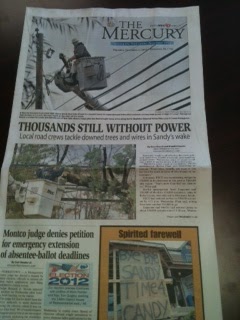Last year, Irene caused some evacuations and flooding of the Perkiomen at Collegeville and Graterford. We had some Floyd-aftermath flooding in 1999, and I remember writing headlines about the approach of Gloria some years back.
But for full-fledged hurricane reporting, we have to go back 40 years to Hurricane Agnes.
Until this week and Sandy.
 Like Agnes in June, 1972, Sandy set her sights on New York and New Jersey, and slammed Pennsylvania in-between with gale-force winds and drenching rain.
Like Agnes in June, 1972, Sandy set her sights on New York and New Jersey, and slammed Pennsylvania in-between with gale-force winds and drenching rain.The AP reported winds reached 81 miles per hour in Allentown; Hanover, Pa. got 8.15 inches of rain.
Twelve deaths were reported in Pennsylvania, several of them from carbon monoxide poisoning from generators.
In our area, a 62-year-old man was killed when a tree crashed through his porch roof while he was taking the dogs out.
The biggest difference between reporting a hurricane and reporting some after-effects like flooding is the breadth of the storm and the dangers to ourselves.
When I send reporters over to South Pottstown to report on damage to the homes along the Schuylkill River, I tell them to wear boots, protect cameras and stay out of deep water.
But on Monday with Sandy "looming large," the warnings were more stern. We put a plan in place to keep paginators and online producers at home, as long as their power lasted. We bought car chargers for laptops; put fresh batteries in flashlights; kept cell phones fully charged.
 Reporters and photographers and two editors were in the office, coordinating coverage. We planned a front page by phone, brainstormed headlines like we always do, but in phone and email instead of in person. We kept website, Facebook, Twitter and mobile sites up to date.
Reporters and photographers and two editors were in the office, coordinating coverage. We planned a front page by phone, brainstormed headlines like we always do, but in phone and email instead of in person. We kept website, Facebook, Twitter and mobile sites up to date.By 8 p.m. Monday night, we closed up at the offices and drove home just as the wind speeds were picking up. Two people were on alert to go out overnight if they got word of a water rescue, fire or building collapse. The message was: Don't go out for flooding or wind damage. That can wait until daybreak. Don't risk going out in this wind unless it's a disaster that demands immediate reporting.
 By Tuesday, many of us had lost power in our homes, but The Mercury did not. Neither did the offices of our sister sites in the Philly cluster, except Montgomery Media and a portion of the Delco Daily Times building.
By Tuesday, many of us had lost power in our homes, but The Mercury did not. Neither did the offices of our sister sites in the Philly cluster, except Montgomery Media and a portion of the Delco Daily Times building.To be sure, not all systems were working perfectly due to the devastation Sandy caused around us, in New York City and the Jersey shore. But for the most part, we could work.
The greatest damage here were giant trees uprooted, wires down and limbs everywhere. Fortunately, none of our staffers suffered damage to their homes except for some damaged gutters and broken tree limbs. The inconvenience of losing cable or Internet or lights and TV is minor compared to what we witnessed at the beach and in New York City.
Ironically, Sandy stormed our way the year of the 40th anniversary of Agnes and a recap of that coverage. There was no comparison to the devastation caused by Agnes, but the approach was the same.
 When we pulled out the old Agnes papers for research last summer, we noticed there were no bylines in those editions, just a box that said everyone on staff contributed to everything they produced.
When we pulled out the old Agnes papers for research last summer, we noticed there were no bylines in those editions, just a box that said everyone on staff contributed to everything they produced.That's how The Mercury covered a hurricane 40 years ago.
With a bit of sarcasm and some silliness, our staffers like to say "there's no I in team." (I won't repeat the second half of their slogan about three "u"s.)
That's how we covered Sandy, and why it was different than a normal storm.
The bylines don't matter in a hurricane; the team effort does.
No comments:
Post a Comment